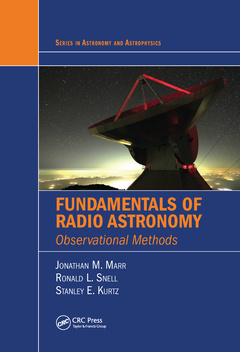Fundamentals of Radio Astronomy Observational Methods Series in Astronomy and Astrophysics Series
Auteurs : Marr Jonathan M., Snell Ronald L., Kurtz Stanley E.

As evidenced by five Nobel Prizes in physics, radio astronomy in its 80-year history has contributed greatly to our understanding of the universe. Yet for too long, there has been no suitable textbook on radio astronomy for undergraduate students.
Fundamentals of Radio Astronomy: Observational Methods is the first undergraduate-level textbook exclusively devoted to radio astronomy telescopes and observation methods. This book, the first of two volumes, explains the instrumentation and techniques needed to make successful observations in radio astronomy. With examples interspersed throughout and problems at the end of each chapter, it prepares students to contribute to a radio astronomy research team.
Requiring no prior knowledge of astronomy, the text begins with a review of pertinent astronomy basics. It then discusses radiation physics, the collection and detection of astronomical radio signals using radio telescopes, the functioning of various components of radio telescopes, and the processes involved in making successful radio observations. The book also provides a conceptual understanding of the fundamental principles of aperture synthesis and a more advanced undergraduate-level discussion of real-world interferometry observations.
Web ResourceA set of laboratory exercises is available for download on the book?s CRC Press web page. These labs use the Small Radio Telescope (SRT) and the Very Small Radio Telescope (VSRT) developed for educational use by MIT?s Haystack Observatory. The web page also includes a Java package that demonstrates the principles of Fourier transforms, which are needed for the analysis of interferometric data.
Introductory Material. Introduction to Radiation Physics. Radio Telescopes. Single-Dish Radio Telescope Observations. Aperture Synthesis Basics: Two-Element Interferometers. Aperture Synthesis: Advanced Discussion. Appendices.
Jonathan M. Marr is a senior lecturer of physics and astronomy at Union College. His research involves high-resolution, radio-wavelength observations of radio galaxies and the Galactic center. He earned a PhD in astronomy from the University of California, Berkeley.
Ronald L. Snell is a professor of astronomy at the University of Massachusetts, Amherst. His research interests include the physical and chemical properties of molecular clouds, star formation, and molecular outflows; he also has extensive experience observing at radio wavelengths. He earned a PhD in astronomy from the University of Texas at Austin.
Stanley E. Kurtz is a professor of radio astronomy and astrophysics at the National Autonomous University of Mexico. His research interests include massive star formation, the interstellar medium, and radio astronomy instrumentation and techniques. He earned a PhD in physics from the University of Wisconsin at Madison.
Date de parution : 06-2020
17.8x25.4 cm
Date de parution : 12-2015
Ouvrage de 352 p.
17.8x25.4 cm
Thèmes de Fundamentals of Radio Astronomy :
Mots-clés :
Ux Density; Beam Pattern; Radio Telescope; Electric Elds; Astronomical Source; Integration Time; Stokes Parameters; Fringe Function; Digital Spectrometer; Antenna Temperature; Brightness Temperature; Aperture Synthesis; Phase Center; Radio Astronomy; Angular Size; Radio Source; Feed Horn; Main Beam; Noise Temperature; Circular Polarization; Edge Taper; Planck Function; Lo Frequency; Eective Area; Rayleigh Jeans Approximation



